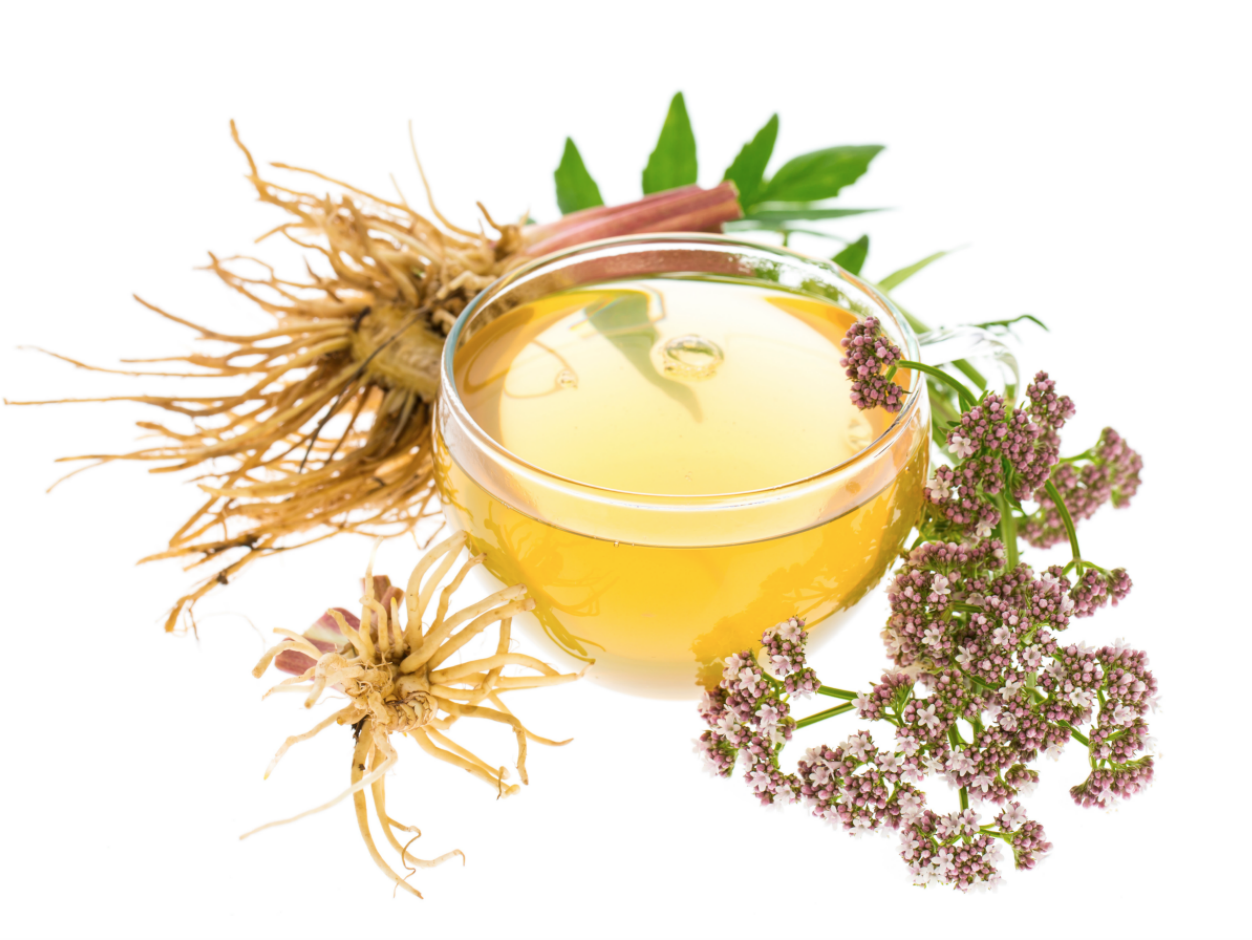Is Valerian Root Tea the Answer to Better, More Restful Sleep?

If you struggle with insomnia or have difficulty relaxing at night, then you might want to sip on a cup of valerian root tea before heading to bed. Known for its ability to help you sleep better, ease your nerves, calm your mind, and relax your body, valerian root has been used for centuries as a natural remedy for countless ailments.
What is valerian root tea?
Valerian root tea is a brew that uses valerian root as its primary ingredient. Valerian root is taken from the valerian plant, which is native to Europe and parts of Asia. The medicinal properties come from drying the root of the plant and using it in various remedies to help induce sleep, calm nerves, and reduce stress.
Valerian root has been used for medicinal purposes for thousands of years, according to the National Institutes of Health. It can be purchased as a health supplement and used in many different forms, including tinctures, capsules, and tablets, but many people opt to drink it in the form of warm valerian root tea right before bed because it has been shown to help ease nerves and encourage sleep.
“Valerian is a non-addictive and safe botanical with mild anxiety and sleep-inducing effects,” explains Elizabeth Trattner, AP, LAc., Dipl. Ac., NCCAOM, a board-certified acupuncturist who practices integrative and Chinese medicine.
“Valerian is a non-addictive and safe botanical with mild anxiety and sleep-inducing effects,” explains Elizabeth Trattner, A.P., L.Ac., Dipl. Ac., NCCAOM, a board-certified acupuncturist who practices integrative and Chinese medicine.
Valerian root tea health benefits are numerous, but get ready to plug your nose when you drink it. Dr. Trattner says that valerian root tea has a distinct pungent smell of dirty socks. If you’re very sensitive to smells, you may want to try standardized capsules instead of valerian root tea.

(Photo Credit: Getty Images)
Valerian Root Tea Benefits
By now you probably have a general sense of valerian root’s primary health benefit — calming — but what is valerian root tea good for, exactly? Well, imagine having a safe, non-habit-forming solution to your mild anxiety and sleep problems at night that you can sip on; that’s the way many people describe valerian root tea health benefits. But let’s dive into the specifics, shall we?
Valerian root tea is most known for its use as a sleep aid and its relaxing and sedative properties. As a result, it is most often used for inducing sleep and managing chronic insomnia. There have been several studies done on the effectiveness of valerian root tea for sleep.
In a May 2017 study published in Nature and Science of Sleep, researchers looked at various herbal supplements for treating insomnia. They tested 120 subjects with sleep disturbance symptoms. The 120 participants were randomized in two groups of 60 each, receiving either the placebo or the dosage of two pills per day 30 minutes before their scheduled bedtime.
The study found a statistically significant difference between the two groups. The group receiving the compound showed a lower time of sleep onset, more total sleep time, and fewer night awakenings compared to the placebo group. And the researchers found evidence that botanical dietary supplements with relaxing and soothing properties — valerian root among them — may help practitioners treat insomnia.
Valerian root tea has been known to help with various sleep issues, including trouble falling asleep, frequent wakefulness in a mid-sleep cycle, and inability to fall back to sleep after waking in the middle of the night.
In addition to its ability to help with sleep, you may be able to use valerian root tea for anxiety. In fact, because valerian root tea is also good for relaxing muscles and calming nerves, it’s sometimes used in place of anxiety medications, according to herbalist Karen Brennan, MSW, NC.
Valerian root is known to increase a calming neurotransmitter called gamma aminobutyric acid (GABA) in the body. Brennan says valerian root tea has also been found useful for headaches, ADHD, stress, restlessness, muscle and arthritis pain, and menstrual cramping.
Even though valerian root tea is well known for its ability to help induce sleep, Trattner says it’s important to remember that the herb takes time to work and will not help you fall asleep immediately; valerian root tea usually requires two to three weeks of nightly use before you see a difference.
The recommended adult dosage of valerian root is 1 to 3 grams of the root (or 800 to 1,200 mg of an extract standardized to 0.8 to 1.0 percent valerenic acid) taken 30 to 60 minutes before bedtime. Because of the time it takes for your body to respond to valerian root tea, you might only want to use it if you have chronic insomnia.
Valerian Root Tea Side Effects
Because people drink valerian root tea to aid sleep and calm nerves, it makes sense that the main side effect of valerian root tea would be drowsiness. Brennan recommends trying valerian root tea at home and not doing any complicated tasks afterward until you know how your body responds to it.
Not everyone reacts the same way to valerian root. In fact, while some people can fall asleep right away, others might have the opposite reaction and become wired. This is another good reason to try valerian root tea at home on a night when your sleep could be disrupted with little to no complications the next day.
It’s wise to stick to the recommended dose of valerian root tea for your needs. Using too much could lead to a valerian root tea overdose and cause headaches, dizziness, and gastrointestinal disturbances. Other valerian root tea side effects include mental dullness, uneasiness, excitability (if you have the opposite reaction), and heart disturbances. If you drink valerian root tea at a higher dose than is recommended, you may also feel sluggish the next morning.
Considering one of the main risks of taking prescription sleep aids is becoming dependent on them, it’s reasonable — and smart — to want to ask, “Is valerian root addictive?” Unlike other sleep medications that can cause you to become dependent on them for falling and staying asleep, valerian root tea is non-habit forming. That said, even though valerian root tea is not considered addictive, you may experience withdrawal symptoms if you abruptly stop drinking the tea, which is why it’s best to reduce your intake over time.
The effects of valerian root tea on the heart could be an issue. There have been some valerian root tea dangers associated with heart disturbances, especially if you are taking a medication to treat a heart or blood pressure condition. If you have a heart condition, it’s wise to talk with your doctor prior to using valerian root tea.
Is valerian root tea safe?
Safety is always something that comes up when using a supplement. When trying to decide if a product is safe for you, it’s best to start by speaking with your doctor. If they give you the go-ahead to try valerian root tea, you might want to take your research one step further and talk with an herbalist.
Valerian root is sold as a dietary supplement and regulated as a food in the United States, which means that premarket evaluation and approval is not required by the Food and Drug Administration, and resulting products can vary in potency and quality. That’s why it’s best to work with an herbalist who can help you find the highest quality valerian root tea to fit your needs.
The good news is that valerian root tea is listed as Safety Class 1 by the American Herbal Products Association, which means it’s considered safe for consumption, says Shari Auth, DACM, LAC, LMT, a board-certified acupuncturist and herbalist; however, Auth says there are some instances when valerian root tea can be dangerous.
Drinking valerian root tea during pregnancy is not recommended. Women who are pregnant or nursing should not take valerian root without medical advice, according to the National Institutes of Health, and children under three years old should also avoid valerian.
Mixing alcohol or drugs — such as barbiturates, benzodiazepines, anticonvulsants, and antidepressants — with valerian root can increase your risk of adverse effects. Experts advise that you avoid driving or operating any machinery if you plan on drinking valerian root tea due to its sedative nature. It’s best used when you are ready to settle in and go to bed.
How to Make Valerian Root Tea
There are a variety of ways to make and brew valerian root tea, so it’s a good idea to experiment with different brands and methods to find a valerian root tea recipe that works for you. Valerian root tea is often found in nighttime teas and can be combined with other sleep-inducing herbs, such as lavender, jasmine, and chamomile.
If you’re looking for the best valerian root tea you can purchase at the store, Auth recommends Hey Girl, It’s Bedtime ($17.09 for 18 bags, Amazon), a ready-made nighttime tea blend that contains valerian root and other herbs.
Sunny Brigham, MS, CNS, a board-certified clinical and integrative nutritionist, recommends buying and using valerian root tea the way that is easiest for you. She suggests trying commercial brands of valerian root tea, such as Traditional Medicinals’ Nighty Night tea ($22.17 for 16 bags, Amazon) or Alvita’s Valerian Root tea ($12.67 for 24 bags, Amazon). Yogi also has a sleepy-time tea with valerian root in it. Brigham says that purchasing the dried herb from a reputable source is also an option.
The correct valerian root tea dosage depends on the product you buy. But typically, you will use one valerian root tea bag to make your tea. You can make a valerian root tea or infusion with herbs purchased either commercially or in bulk. Place a valerian root tea bag in a cup and pour boiling water over it. Cover the cup to trap the steam. Brigham recommends covering the cup with another cup, then allowing the tea to steep for 10 minutes.
If you are looking for something stronger than tea, Brigham says you can try a valerian root infusion, which would be stronger than the valerian root tea. An herbal infusion is very much like a tea, only it is steeped longer and uses a larger amount of herb. If you plan on making an infusion, she says to double the amount of tea and allow it to steep for several hours. This makes the brew stronger and sometimes more effective.
When it comes to deciding which method to use, Brigham explains that utilizing a valerian root tea or valerian root infusion really depends on the level and length of symptoms, as well as on your overall health.
Many people decide to make their own valerian root tea from scratch. If you want to know how to brew valerian root tea at home, Brennan recommends the following recipe for valerian root tea:
- To make valerian root tea, steep a teaspoon of the dried root in one cup of hot water for 10 minutes (roots need to steep longer than the aerial parts of a plant).
- Strain and drink.
- If you are using this as a sleep aid, consume 30 to 60 minutes before bedtime.
- The root has a distinct aroma. Some people like the scent, while others do not. In order to make valerian root tea taste (and smell) better, you can add a bit of raw honey to the tea.
- Choose organic valerian root whenever possible.
If you’re wondering how to make valerian root tea taste better, you’re not alone. In addition to adding honey, there are a variety of other ways to make valerian root tea taste better. You can add sugar, milk, lemon, and peppermint to minimize some of the bitter taste. If you want to minimize the valerian root tea smell, consider steeping the valerian root tea bags for a shorter amount of time. The longer the tea steeps, the stronger the odor and taste become.
This post was written by Sara Lindberg.
More from Woman’s World
The ‘Sleep Diet’ Is One We’re Happy to Sign Up For
Instantly Soothe Anxiety with These Amazing Natural Remedies













